Top ratings
Get free trial access now Try first, then study!
4.92/5.0 (from 386 Trusted Shops Reviews )
4.9/5.0
- Google reviews
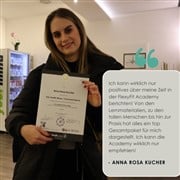

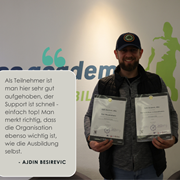

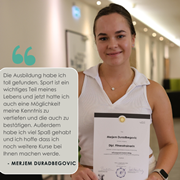
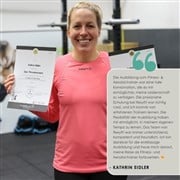
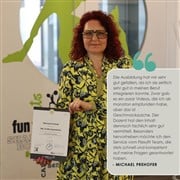

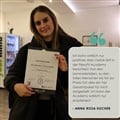

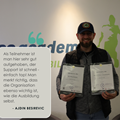


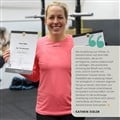
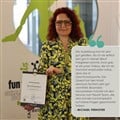
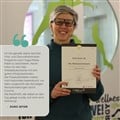

starting at €2.290,- | face-to-face course
» Our Course Packages
Flexible learning - our possible learning options for the course:
Recognized & Certified
Our graduates, partners & friends say
Our team will be happy to advise you at any time by phone, chat or in person
Extent of learning
534 E
EQF level
The training is based on EQF level 4 »
Course start
Possible immediately
Learning variant
Classroom Courses


Our swimming coach training course provides you with everything you need to start your career in the sport & health sector. Whether you want to work as a professional swimming coach or simply want to optimize your own training: With the Trainer A license, you are laying the first foundation stone in the right direction!
Benefit from the comprehensive specialist knowledge of our academic instructors on the subject of water sports in face-to-face course units.
In the introductory module, we will first get to know the basic concepts of anatomy, physiology and training science. In addition, nutrition-specific topics, professional aspects and first aid measures for sports injuries will play an important role in our training program.
During our practice-oriented teaching units, you will get to know different swimming styles and be able to analyze them with the help of video recordings. We will also take an in-depth look at strength training and movement theory, including practical exercises in the water to apply what you have learned directly.
After our training, you will be able to support aquatic athletes in their preparation for swimming competitions. Whether as a swimming instructor for adults and children or a coach for professional athletes, nothing stands in the way of your career.
Our certificates are valid worldwide and are issued in different versions. On request, you can receive our certificate in several languages (DE, EN, ES), with country-specific information and with or without printed grades.
All these variants are available to you free of charge for a lifetime for downloading from your online campus. In addition, depending on the learning package you have purchased, you will receive a certificate of your choice, which will be issued on high-quality special paper with embossed printing.
The following certificate will be awarded (in several languages DE, EN, ES):
We are happy to help you by phone, e-mail or chat . However, you may find the answer to your question in our general FAQ or swimming coach FAQ.
You start your training with the basic module Sports Competence. You will learn theoretical knowledge from videos and scripts in 8 subjects, completing each subject with a short multiple-choice online exam.
You then move on to your subject specialization, i.e. your chosen course.
As our training courses are designed to be very flexible, the duration of the course depends heavily on your own learning initiative, the amount of time you spend each week and your previous knowledge.
You can start the basic sports competence module online at any time. This not only bridges the waiting time until the face-to-face lessons, but also allows you to acquire important basic knowledge.
You will learn in a group of 5 to 15 people in practice-oriented face-to-face lessons. Instructors teach you what you need to know as a trainer and support you with valuable tips for your day-to-day work.
You earn your grade with practical exercises and voluntary additional tasks. These exercises can range from training protocols and written assignments to filming exercises.
During your training, you can expect both multiple choice online intermediate exams and a final exam in person.
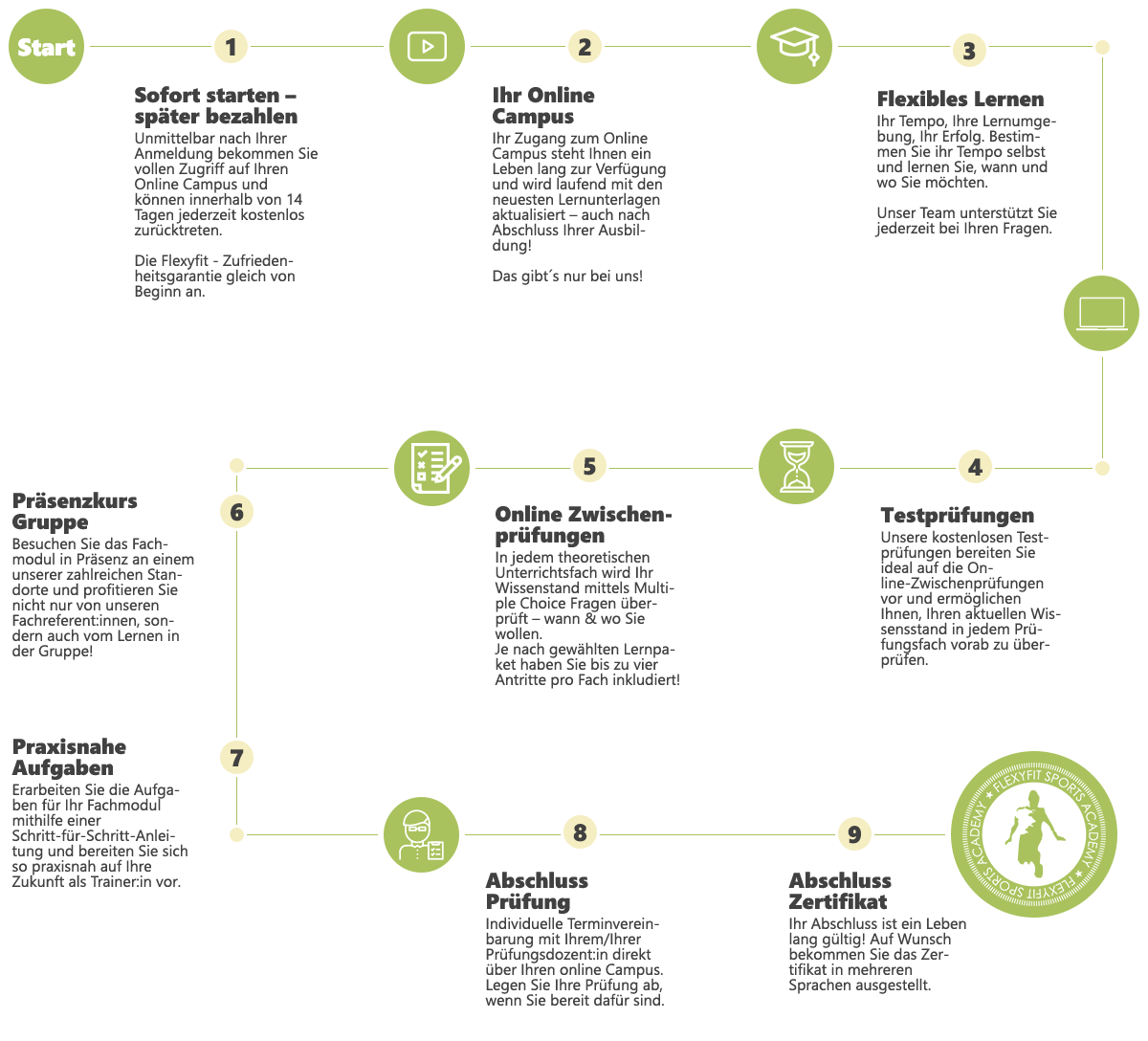
Extent of learning
200
Sports expertise
295
Presence | Self-study
6
Literature research
30
Practical realization
3
Additional tasks & examinations
This course is ideal for educational leave. Individual assessment and approval is carried out by the respective funding body. We will be happy to provide you with detailed information on the duration and procedure of educational leave. Contact us to arrange a consultation!
Participation in the face-to-face webinars is mandatory for educational leave and must be proven to the AMS. The participant is responsible for requesting confirmation of attendance. Confirmation of attendance of the face-to-face webinar will only be issued during each webinar if requested by the participant.
Show all chapters of the subjects

We educate the best trainers in the fitness branch. From start to finish of the education - and beyond!- we support and guide our students.
Functional anatomy is a foundation necessary for all trainers in exercise, fitness and sports. This subject provides a comprehensive introduction to the anatomy of the human body and a wellspring of important knowledge.
The course is constructed to present the information in an interesting and comprehensible manner and features different learning approaches appropriate for Fitness and Personal Trainers.
The goal is, to understand the relationship between movement patterns, the human body and relevant anatomical terminology.
Show chapter

Show chapter

Show chapter

More and more companies are integrating Corporate Wellness and similar health initiatives into their employee benefits packages. By doing so they promote the health and well-being of their employees, reducing the incidence of sick-leave and building healthier, stronger team dynamics.
Exactly why such initiatives are important is discussed in this introduction to the concept, as well as challenges that such initiatives face including organisational dysfunction.
Participants also learn about the advantages of corporate wellness and some trusted approaches and tools for finding and working with a company.
We offer suggestions on how to approach companies about Corporate Wellness, how to develop a corporate wellness concept and important organisational points to consider.
Participants will be exposed to some practical examples and will have the possiblity to perform group work on the topic.
Show chapter

The unit on Marketing and Customer Interaction gives participants some insight into identifying, working with and marketing to their ideal customer. This is one of the most useful units for the aspiring trainer, as it helps them identify their place in the market, which makes for a more successful career start.
We begin by taking a look at Marketing itself to understand exactly what it is and of what relevance it has for personal trainers.
Important basic concepts such as USP, positioning, target market, etc. are introduced and different models from marketing such as the SMART Formula, marketing mix (7Ps) and more are explained.
The communication between trainer and client is also addressed in this unit. Various aspects of communication theory and some guidelines for successful communication are covered.
Upon completion of this subject, participants are able to develop marketing strategies for their product and/or services, ready to position themselves in a market rich in variety and full of possibility!
Show chapter

A working understanding of human physiology and therefore the relationships between the various functions of the human body is crucial for anyone working in the exercise and fitness field. It is a requisite knowledge for the sufficient practice of their profession.
This course makes the relationships within the human organism graspable for everyone. Take a deep-dive into the human body and learn the functions of our organism for your new profession in fitness.
In this subject you will get a close look at energy metabolism needed for muscle activation, the circulatory system and the pulmonary system.
Any high quality education in fitness and exercise begins with the foundations of anatomy and physiology.
Show chapter

In this unit participants are prepared for successful communication with their clients on every level. In addition, we take a look at how the trainer or coach can go about dealing with their own goals and motives, which will in turn help them better understand their clients.
The right goal-setting and the proper approach to feedback are an important parts of this unit.
The way we manage stress as trainers and with our clients and a variety of learning strategies are explored so these skills can be integrated into your professional approach.
Show chapter

In this introduction to training theory we look at the foundations of training plan creation and management, including the principles of training, training methodology and factors that influence sports performance.
Because performance capacity, performance diagnostics, training and competition are so interrelated, they are covered together in this unit.
The second half of this unit Im zweiten Teil der Trainingslehre wird das Training als komplexer Handlungsprozess und im Zusammenhang mit Planung, Ausführung und Evaluation definiert und bewertet.
Ein wichtiger Teil der Trainingslehre ist nach wie vor die Trainingsplangestaltung, die mit Beispielen über die Möglichkeiten einer Trainingsplangestaltung praktisch vermittelt werden.
Um das Thema der Trainingswissenschaft zu vertiefen, laden wir regelmäßig internationale Top-Dozenten wie Univ. Prof. Dr. Paul Haber und Prof.em. Dr.phil. Dr.med. Dr. hc Jürgen Weineck zu uns in die Academy ein.
Unter anderem sind sie für die Bücher "Optimales Training" (Jürgen Weineck) und "Leistungsphysiologie" (Paul Haber) in der Trainingswissenschaft bekannt.
Show chapter
Show all chapters of the subjects

Show chapter

Show chapter

The breaststroke is one of the most well-known swimming techniques and is preferred by many swimmers due to its versatility and effectiveness. The breaststroke uses the so-called undulation technique, which is an undulating water position that constantly changes depending on the propulsion phase. This technique requires a high level of agility. Compared to other swimming techniques such as the crawl or backstroke, breaststroke is characterized by a number of special features.
One special feature of breaststroke is the movement of the arms and legs. In contrast to the crawl, in which the arms and legs work in one continuous movement, in breaststroke the arms and legs move one after the other and require precise coordination. The arm movement is divided into an outward, pull and return phase. The leg movement is divided into a pull and stroke phase. Important nodal points in breaststroke are the head position, stable wrists, gliding phases and body tension. Special attention must also be paid to breathing.
In order to learn the breaststroke optimally in practice, it is important to first understand the basic techniques of the swimming technique. This includes the correct posture, the movement of the arms and legs and the breathing technique. Swimmers should focus on improving their technique rather than concentrating on speed. By improving their technique, they can improve their efficiency in the water and increase their speed.
The breaststroke requires a high level of coordination and concentration in order to learn it optimally in practice. By training regularly and focusing on technique, swimmers can improve their performance in the water and achieve their swimming goals. In the course of the lessons, all the points mentioned are addressed and practiced. The methodical structure is also discussed and various corrective measures are demonstrated.
Show chapter

Show chapter

As a centrally symmetrical movement, the crawl is easier to learn than other types of swimming. Due to the low water resistance, it is the fastest way to move in the water with comparatively little effort. It also has a "healthier" leg movement, as the alternating arm pull and continuous leg stroke generate uninterrupted propulsion and the knee is used as a hinge joint.
The crucial point is the arm pull. It is important to note that the arm pull exerts pressure backwards, not downwards. There are different technique variations for the crawl, such as the front-square swim (crawl with glide phase), the paddle principle and the swing principle. In contrast to the other two swimming techniques, breaststroke and dolphin, the water position in the crawl is stretched, with a lower angle of attack of the body to the waterline. Correct breathing is a frequent obstacle. Many find it difficult to find the right rhythm or start exhaling too late. A good swimming coach recognizes mistakes in their clients' technique and knows how to teach them the correct technique using aids and partial exercises. There is no single recipe that works for every client, as the sources of errors and individual comprehension vary greatly.
In the course of the lesson, the basics of crawling, water position, rotation and breathing are developed. Subsequently, the correct leg stroke is discussed in more detail and the correct execution of the arm stroke on land and in the water is practiced. In addition to learning the correct technique, emphasis is also placed on being able to teach it to others.
Show chapter

Show chapter

With methodical series of exercises, we look at how to correct typical mistakes in crawl swimming/breaststroke/backstroke/dolphin swimming with and without aids. We then work on rhythm and exercises to improve speed and tempo. Of course, starts and turns are also part of the in-depth training!
Show chapter

The back crawl is very similar to the movement sequence of the classic crawl swim. The biggest difference lies in the supine position. This means that your mouth and nose are always out of the water, which eliminates coordination difficulties when breathing. As the technique is relatively easy to learn, this variant is particularly suitable for fitness athletes. The positive health effect of this variant is also a major advantage. People who sit a lot in everyday life in particular can benefit from training the muscles used in the back crawl. The gentle training of the back, gluteal, abdominal, shoulder and arm muscles can help with back pain or at least prevent it.
Of course, there are also some basic technical principles to follow when swimming backstroke. These include, above all, the body and head position as well as the correct arm stroke and leg stroke. A good swimming coach knows these and can support their customers with the right coaching points and various aids to help them recognize and relearn incorrectly learned techniques or practice the correct technique right from the start. During the lessons, the correct water position and head position are discussed first, followed by learning the correct arm stroke on land and in the water, and finally the correct technique is worked out step by step using methodical series in the water. Typical mistakes are discussed and corrective measures are shown.
Show chapter

Show chapter

Swimming training is an effective and popular method for improving physical fitness and optimizing swimming technique. Effective lesson design and a correct methodical structure are of great importance for successful swimming training.
The lesson structure can vary depending on the objective and performance level. In general, swimming training begins with a warm-up program consisting of light swimming exercises or techniques. This is followed by the main part, which is aimed at improving swimming technique, strength and endurance. The main part can be designed using swimming sets with different intensities, distances and breaks. The training session ends with a cool-down phase consisting of relaxed swimming or stretching exercises.
The swimming training methodology can vary depending on the focus of the training session. One important aspect is the improvement of swimming technique, which can be achieved through specific exercises. For example, swimming boards, pull buoys or fins can be used to improve technique and strength in certain areas of the body.
Another important methodology in swimming training is to increase endurance and speed through interval training and swimming sets with different intensities. The training can be focused on a specific distance or time in order to achieve an improvement in performance.
Overall, effective lesson planning and methodology in swimming training is important in order to achieve progress and avoid injuries. Targeted planning and orientation of training can improve physical fitness and swimming technique.
Show chapter

Training theory in swimming is a special theoretical discipline that aims to optimally prepare swimmers for competitions and improve their performance. Based on the training theory from Sportkompetent, various swimming-specific aspects are taken into account, such as training intensity, training duration, technique and regeneration. In the course of the lessons, our course participants learn the theoretical background of conditional abilities in swimming, energy supply, load parameters and training control as well as relevant training methods in swimming.
An important aspect of training theory in swimming is training intensity. The intensity is determined by the swimming speed, which is usually measured in meters per minute. The higher the intensity, the greater the demands on the body and the greater the strain on the organism. One way to increase the intensity is through targeted interval training, in which short sections are swum at high intensity with short breaks in between. Another important aspect is the duration of training. The duration of training depends on the individual performance level of the swimmer and can range from 30 minutes to several hours, depending on the objective. It is important that the training duration is not too short or too long in order to achieve an optimum training effect.
In addition to stressing the body, regeneration is also an important part of swimming training theory. Targeted regeneration measures such as stretching, massage or rest phases between training sessions prepare the body for the next training session. With the knowledge they have gained, our course participants are able to create scientifically sound training plans and units and adapt their training to suit every performance level.
Show chapter

Show chapter
The basic module Sports Competence is approved by the German Central Agency for Distance Learning (ZFU) under the following number: 7324018c. The ZFU is the central authority for distance learning in Germany and works on the basis of the Distance Learning Protection Act (FernUSG). It decides on the approval of distance learning courses nationwide in order to guarantee a technically correct and generally professional distance learning course.
As a recognized institution in adult education, our curricula are regularly evaluated and recognized by state institutions and funding bodies. We are constantly striving to exceed current quality standards in order to guarantee you the best possible training. Convince yourself of our certifications.
There are a variety of funding options for training courses at the Flexyfit Sports Academy. State-specific and EU funding as well as tax-related options form the basis for this.
However, we would like to point out that the respective funding body is solely responsible for deciding on the allocation or amount of funding.
We will be happy to help you find a suitable funding body and compile all the course information you need for a funding application. You must submit the application itself to the funding body.
You can find an overview of the most important funding bodies here.
Depending on the funding institution, the training costs are either paid directly after the funding application has been confirmed (e.g. AMS) or reimbursed in full or in part after successful completion of the training (e.g. waff). Please contact the funding institutions yourself to find out how the funding works.
Yes, the majority of our courses are suitable for educational leave.
If you want to continue your education without terminating your employment, you can arrange educational leave with your employer. This means you will be released from work for the duration of your training.
Plan your educational leave with us now! We will be happy to clarify your individual training requirements with you in a personal, non-binding consultation.
You can take your educational leave for a maximum of 1 year within 4 years - there are 3 options:
It is important that your employer agrees to you taking educational leave. You must provide evidence of the training plans issued by us to the extent of 20 hours per week in the case of full-time educational leave, or at least 10 hours in the case of part-time educational leave.
You must regularly provide evidence of the progress of your training. For example, in the form of examinations or confirmation of attendance, which you will receive from us.
Swimming coaches give swimming lessons to individuals or groups. They teach various swimming techniques, such as breaststroke, crawl, backstroke and dolphin. The coach analyzes the customers swimming movements, often using video recordings, in order to correct any mistakes and develop a clean technique.
The average salary of a swimming instructor in a permanent position is €1,980 gross per month. However, the focus is more on swimming lessons for groups. If you become self-employed as a swimming coach and prepare athletes professionally for competitions, your income will be significantly higher. You can charge around €65 for an individual lesson. However, it must be taken into account that the entrance fee to the swimming pool must also be covered.
Swimming coaches usually work independently, or in cooperation or permanent employment with swimming and sports schools as well as in indoor and outdoor swimming pools. Swimming coaches and swimming instructors are also often employed by swimming, gymnastics and sports clubs as well as hotels with wellness and fitness facilities.
We regularly list job advertisements from fitness studios on our Sportkarriere platform. There you can apply directly for jobs as a fitness trainer, branch manager, instructor or studio employee.

Our swimming coach training course provides you with everything you need to start your career in the sport & health sector. Whether you want to work as a professional swimming coach or simply want to optimize your own training: With the Trainer A license, you are laying the first foundation stone in the right direction!
Benefit from the comprehensive specialist knowledge of our academic instructors on the subject of water sports in face-to-face course units.
In the introductory module, we will first get to know the basic concepts of anatomy, physiology and training science. In addition, nutrition-specific topics, professional aspects and first aid measures for sports injuries will play an important role in our training program.
During our practice-oriented teaching units, you will get to know different swimming styles and be able to analyze them with the help of video recordings. We will also take an in-depth look at strength training and movement theory, including practical exercises in the water to apply what you have learned directly.
After our training, you will be able to support aquatic athletes in their preparation for swimming competitions. Whether as a swimming instructor for adults and children or a coach for professional athletes, nothing stands in the way of your career.
Our certificates are valid worldwide and are issued in different versions. On request, you can receive our certificate in several languages (DE, EN, ES), with country-specific information and with or without printed grades.
All these variants are available to you free of charge for a lifetime for downloading from your online campus. In addition, depending on the learning package you have purchased, you will receive a certificate of your choice, which will be issued on high-quality special paper with embossed printing.
The following certificate will be awarded (in several languages DE, EN, ES):
We are happy to help you by phone, e-mail or chat . However, you may find the answer to your question in our general FAQ or swimming coach FAQ.
You start your training with the basic module Sports Competence. You will learn theoretical knowledge from videos and scripts in 8 subjects, completing each subject with a short multiple-choice online exam.
You then move on to your subject specialization, i.e. your chosen course.
As our training courses are designed to be very flexible, the duration of the course depends heavily on your own learning initiative, the amount of time you spend each week and your previous knowledge.
You can start the basic sports competence module online at any time. This not only bridges the waiting time until the face-to-face lessons, but also allows you to acquire important basic knowledge.
You will learn in a group of 5 to 15 people in practice-oriented face-to-face lessons. Instructors teach you what you need to know as a trainer and support you with valuable tips for your day-to-day work.
You earn your grade with practical exercises and voluntary additional tasks. These exercises can range from training protocols and written assignments to filming exercises.
During your training, you can expect both multiple choice online intermediate exams and a final exam in person.

Extent of learning
200
Sports expertise
295
Presence | Self-study
6
Literature research
30
Practical realization
3
Additional tasks & examinations
This course is ideal for educational leave. Individual assessment and approval is carried out by the respective funding body. We will be happy to provide you with detailed information on the duration and procedure of educational leave. Contact us to arrange a consultation!
Participation in the face-to-face webinars is mandatory for educational leave and must be proven to the AMS. The participant is responsible for requesting confirmation of attendance. Confirmation of attendance of the face-to-face webinar will only be issued during each webinar if requested by the participant.
Show all chapters of the subjects

We educate the best trainers in the fitness branch. From start to finish of the education - and beyond!- we support and guide our students.
Functional anatomy is a foundation necessary for all trainers in exercise, fitness and sports. This subject provides a comprehensive introduction to the anatomy of the human body and a wellspring of important knowledge.
The course is constructed to present the information in an interesting and comprehensible manner and features different learning approaches appropriate for Fitness and Personal Trainers.
The goal is, to understand the relationship between movement patterns, the human body and relevant anatomical terminology.
Show chapter

Show chapter

Show chapter

More and more companies are integrating Corporate Wellness and similar health initiatives into their employee benefits packages. By doing so they promote the health and well-being of their employees, reducing the incidence of sick-leave and building healthier, stronger team dynamics.
Exactly why such initiatives are important is discussed in this introduction to the concept, as well as challenges that such initiatives face including organisational dysfunction.
Participants also learn about the advantages of corporate wellness and some trusted approaches and tools for finding and working with a company.
We offer suggestions on how to approach companies about Corporate Wellness, how to develop a corporate wellness concept and important organisational points to consider.
Participants will be exposed to some practical examples and will have the possiblity to perform group work on the topic.
Show chapter

The unit on Marketing and Customer Interaction gives participants some insight into identifying, working with and marketing to their ideal customer. This is one of the most useful units for the aspiring trainer, as it helps them identify their place in the market, which makes for a more successful career start.
We begin by taking a look at Marketing itself to understand exactly what it is and of what relevance it has for personal trainers.
Important basic concepts such as USP, positioning, target market, etc. are introduced and different models from marketing such as the SMART Formula, marketing mix (7Ps) and more are explained.
The communication between trainer and client is also addressed in this unit. Various aspects of communication theory and some guidelines for successful communication are covered.
Upon completion of this subject, participants are able to develop marketing strategies for their product and/or services, ready to position themselves in a market rich in variety and full of possibility!
Show chapter

A working understanding of human physiology and therefore the relationships between the various functions of the human body is crucial for anyone working in the exercise and fitness field. It is a requisite knowledge for the sufficient practice of their profession.
This course makes the relationships within the human organism graspable for everyone. Take a deep-dive into the human body and learn the functions of our organism for your new profession in fitness.
In this subject you will get a close look at energy metabolism needed for muscle activation, the circulatory system and the pulmonary system.
Any high quality education in fitness and exercise begins with the foundations of anatomy and physiology.
Show chapter

In this unit participants are prepared for successful communication with their clients on every level. In addition, we take a look at how the trainer or coach can go about dealing with their own goals and motives, which will in turn help them better understand their clients.
The right goal-setting and the proper approach to feedback are an important parts of this unit.
The way we manage stress as trainers and with our clients and a variety of learning strategies are explored so these skills can be integrated into your professional approach.
Show chapter

In this introduction to training theory we look at the foundations of training plan creation and management, including the principles of training, training methodology and factors that influence sports performance.
Because performance capacity, performance diagnostics, training and competition are so interrelated, they are covered together in this unit.
The second half of this unit Im zweiten Teil der Trainingslehre wird das Training als komplexer Handlungsprozess und im Zusammenhang mit Planung, Ausführung und Evaluation definiert und bewertet.
Ein wichtiger Teil der Trainingslehre ist nach wie vor die Trainingsplangestaltung, die mit Beispielen über die Möglichkeiten einer Trainingsplangestaltung praktisch vermittelt werden.
Um das Thema der Trainingswissenschaft zu vertiefen, laden wir regelmäßig internationale Top-Dozenten wie Univ. Prof. Dr. Paul Haber und Prof.em. Dr.phil. Dr.med. Dr. hc Jürgen Weineck zu uns in die Academy ein.
Unter anderem sind sie für die Bücher "Optimales Training" (Jürgen Weineck) und "Leistungsphysiologie" (Paul Haber) in der Trainingswissenschaft bekannt.
Show chapter
Show all chapters of the subjects

Show chapter

Show chapter

The breaststroke is one of the most well-known swimming techniques and is preferred by many swimmers due to its versatility and effectiveness. The breaststroke uses the so-called undulation technique, which is an undulating water position that constantly changes depending on the propulsion phase. This technique requires a high level of agility. Compared to other swimming techniques such as the crawl or backstroke, breaststroke is characterized by a number of special features.
One special feature of breaststroke is the movement of the arms and legs. In contrast to the crawl, in which the arms and legs work in one continuous movement, in breaststroke the arms and legs move one after the other and require precise coordination. The arm movement is divided into an outward, pull and return phase. The leg movement is divided into a pull and stroke phase. Important nodal points in breaststroke are the head position, stable wrists, gliding phases and body tension. Special attention must also be paid to breathing.
In order to learn the breaststroke optimally in practice, it is important to first understand the basic techniques of the swimming technique. This includes the correct posture, the movement of the arms and legs and the breathing technique. Swimmers should focus on improving their technique rather than concentrating on speed. By improving their technique, they can improve their efficiency in the water and increase their speed.
The breaststroke requires a high level of coordination and concentration in order to learn it optimally in practice. By training regularly and focusing on technique, swimmers can improve their performance in the water and achieve their swimming goals. In the course of the lessons, all the points mentioned are addressed and practiced. The methodical structure is also discussed and various corrective measures are demonstrated.
Show chapter

Show chapter

As a centrally symmetrical movement, the crawl is easier to learn than other types of swimming. Due to the low water resistance, it is the fastest way to move in the water with comparatively little effort. It also has a "healthier" leg movement, as the alternating arm pull and continuous leg stroke generate uninterrupted propulsion and the knee is used as a hinge joint.
The crucial point is the arm pull. It is important to note that the arm pull exerts pressure backwards, not downwards. There are different technique variations for the crawl, such as the front-square swim (crawl with glide phase), the paddle principle and the swing principle. In contrast to the other two swimming techniques, breaststroke and dolphin, the water position in the crawl is stretched, with a lower angle of attack of the body to the waterline. Correct breathing is a frequent obstacle. Many find it difficult to find the right rhythm or start exhaling too late. A good swimming coach recognizes mistakes in their clients' technique and knows how to teach them the correct technique using aids and partial exercises. There is no single recipe that works for every client, as the sources of errors and individual comprehension vary greatly.
In the course of the lesson, the basics of crawling, water position, rotation and breathing are developed. Subsequently, the correct leg stroke is discussed in more detail and the correct execution of the arm stroke on land and in the water is practiced. In addition to learning the correct technique, emphasis is also placed on being able to teach it to others.
Show chapter

Show chapter

With methodical series of exercises, we look at how to correct typical mistakes in crawl swimming/breaststroke/backstroke/dolphin swimming with and without aids. We then work on rhythm and exercises to improve speed and tempo. Of course, starts and turns are also part of the in-depth training!
Show chapter

The back crawl is very similar to the movement sequence of the classic crawl swim. The biggest difference lies in the supine position. This means that your mouth and nose are always out of the water, which eliminates coordination difficulties when breathing. As the technique is relatively easy to learn, this variant is particularly suitable for fitness athletes. The positive health effect of this variant is also a major advantage. People who sit a lot in everyday life in particular can benefit from training the muscles used in the back crawl. The gentle training of the back, gluteal, abdominal, shoulder and arm muscles can help with back pain or at least prevent it.
Of course, there are also some basic technical principles to follow when swimming backstroke. These include, above all, the body and head position as well as the correct arm stroke and leg stroke. A good swimming coach knows these and can support their customers with the right coaching points and various aids to help them recognize and relearn incorrectly learned techniques or practice the correct technique right from the start. During the lessons, the correct water position and head position are discussed first, followed by learning the correct arm stroke on land and in the water, and finally the correct technique is worked out step by step using methodical series in the water. Typical mistakes are discussed and corrective measures are shown.
Show chapter

Show chapter

Swimming training is an effective and popular method for improving physical fitness and optimizing swimming technique. Effective lesson design and a correct methodical structure are of great importance for successful swimming training.
The lesson structure can vary depending on the objective and performance level. In general, swimming training begins with a warm-up program consisting of light swimming exercises or techniques. This is followed by the main part, which is aimed at improving swimming technique, strength and endurance. The main part can be designed using swimming sets with different intensities, distances and breaks. The training session ends with a cool-down phase consisting of relaxed swimming or stretching exercises.
The swimming training methodology can vary depending on the focus of the training session. One important aspect is the improvement of swimming technique, which can be achieved through specific exercises. For example, swimming boards, pull buoys or fins can be used to improve technique and strength in certain areas of the body.
Another important methodology in swimming training is to increase endurance and speed through interval training and swimming sets with different intensities. The training can be focused on a specific distance or time in order to achieve an improvement in performance.
Overall, effective lesson planning and methodology in swimming training is important in order to achieve progress and avoid injuries. Targeted planning and orientation of training can improve physical fitness and swimming technique.
Show chapter

Training theory in swimming is a special theoretical discipline that aims to optimally prepare swimmers for competitions and improve their performance. Based on the training theory from Sportkompetent, various swimming-specific aspects are taken into account, such as training intensity, training duration, technique and regeneration. In the course of the lessons, our course participants learn the theoretical background of conditional abilities in swimming, energy supply, load parameters and training control as well as relevant training methods in swimming.
An important aspect of training theory in swimming is training intensity. The intensity is determined by the swimming speed, which is usually measured in meters per minute. The higher the intensity, the greater the demands on the body and the greater the strain on the organism. One way to increase the intensity is through targeted interval training, in which short sections are swum at high intensity with short breaks in between. Another important aspect is the duration of training. The duration of training depends on the individual performance level of the swimmer and can range from 30 minutes to several hours, depending on the objective. It is important that the training duration is not too short or too long in order to achieve an optimum training effect.
In addition to stressing the body, regeneration is also an important part of swimming training theory. Targeted regeneration measures such as stretching, massage or rest phases between training sessions prepare the body for the next training session. With the knowledge they have gained, our course participants are able to create scientifically sound training plans and units and adapt their training to suit every performance level.
Show chapter

Show chapter
The basic module Sports Competence is approved by the German Central Agency for Distance Learning (ZFU) under the following number: 7324018c. The ZFU is the central authority for distance learning in Germany and works on the basis of the Distance Learning Protection Act (FernUSG). It decides on the approval of distance learning courses nationwide in order to guarantee a technically correct and generally professional distance learning course.
As a recognized institution in adult education, our curricula are regularly evaluated and recognized by state institutions and funding bodies. We are constantly striving to exceed current quality standards in order to guarantee you the best possible training. Convince yourself of our certifications.
There are a variety of funding options for training courses at the Flexyfit Sports Academy. State-specific and EU funding as well as tax-related options form the basis for this.
However, we would like to point out that the respective funding body is solely responsible for deciding on the allocation or amount of funding.
We will be happy to help you find a suitable funding body and compile all the course information you need for a funding application. You must submit the application itself to the funding body.
You can find an overview of the most important funding bodies here.
Depending on the funding institution, the training costs are either paid directly after the funding application has been confirmed (e.g. AMS) or reimbursed in full or in part after successful completion of the training (e.g. waff). Please contact the funding institutions yourself to find out how the funding works.
Yes, the majority of our courses are suitable for educational leave.
If you want to continue your education without terminating your employment, you can arrange educational leave with your employer. This means you will be released from work for the duration of your training.
Plan your educational leave with us now! We will be happy to clarify your individual training requirements with you in a personal, non-binding consultation.
You can take your educational leave for a maximum of 1 year within 4 years - there are 3 options:
It is important that your employer agrees to you taking educational leave. You must provide evidence of the training plans issued by us to the extent of 20 hours per week in the case of full-time educational leave, or at least 10 hours in the case of part-time educational leave.
You must regularly provide evidence of the progress of your training. For example, in the form of examinations or confirmation of attendance, which you will receive from us.
Swimming coaches give swimming lessons to individuals or groups. They teach various swimming techniques, such as breaststroke, crawl, backstroke and dolphin. The coach analyzes the customers swimming movements, often using video recordings, in order to correct any mistakes and develop a clean technique.
The average salary of a swimming instructor in a permanent position is €1,980 gross per month. However, the focus is more on swimming lessons for groups. If you become self-employed as a swimming coach and prepare athletes professionally for competitions, your income will be significantly higher. You can charge around €65 for an individual lesson. However, it must be taken into account that the entrance fee to the swimming pool must also be covered.
Swimming coaches usually work independently, or in cooperation or permanent employment with swimming and sports schools as well as in indoor and outdoor swimming pools. Swimming coaches and swimming instructors are also often employed by swimming, gymnastics and sports clubs as well as hotels with wellness and fitness facilities.
We regularly list job advertisements from fitness studios on our Sportkarriere platform. There you can apply directly for jobs as a fitness trainer, branch manager, instructor or studio employee.

4.92/5.0 (from 386 Trusted Shops Reviews )

Available course variations
Language of Instruction
Course Module
Fitness Fundamentals
Fitness basics (presence)
Fitness Fundamentals Full HD Video Lessons
Course Module Full HD Video Lessons
Course Modality
Study Method
Auditory & Visual Learning Style
Communicative & Kinesthetic Learning Style
Study Timeframe
Text & Presentation PDFs
Support via Online Campus, E-mail, Chat, Tel.
WhatsApp & On-site Support
Test/Dummy Exam
NADA Austria
Altitude Training - Prof. Dr. Weineck
Fitness Fundamentals Theory Exams Online
Final Exam
Certificate in DE, EN or ES
Certificate accepted worldwide & never expires
Lifetime Access to Online Campus
Free Demo Account / Trial Package
Certificate Copy as Downloadable PDF
Certificate with Verification via QR-Code
Financial Aid/Grant Opportunities
Paid Educational Leave (AT)
Grants for Businesses
Grants for Self-Employed Persons
Course Advising
Cost Estimate for Financial Aid Provider
Job Openings Mailing List
Comprehensive Training Opportunities
Absolute Best Price & Service Offer
EN
Group attendance course
online
Optionally bookable
314
postable
online/presence
visual/motor
well suited
well suited
flexible + dates
postable
Flexible date
up to 100%
non-binding
DE, EN
Individual lessons
online
contain
314
One2One
visual/motor
suitable
recommended
individual
contain
individual
up to 100%
non-binding
2 weeks ago
Very well organized team, uncomplicated operation of online lessons, versatile informative script :) All in all top!
posted on
2 weeks ago
I am very impressed with Flexyfit, always nice and helpful people. Very sympathetic. Thank you very much for your great support.
posted on
3 weeks ago
Great training and super nice people. You can tell how much emphasis is placed on conveying the necessary knowledge to the course participants in an understandable way. I was even kindly allowed to take a course completely free of charge after there were somewhat problematic and disruptive participants in my group. I will 100% take more courses with you in the future because learning is extremely fun, especially thanks to the friendly staff!
posted on
3 weeks ago
The entire flexyfit team is extremely friendly, prompt and helpful. The lecturers are competent and respond to the course participants. All learning materials were provided clearly and in sufficient detail. The additional videos mean there is something for every type of learner. All in all, the training and exam went well. I can definitely recommend flexyfit and will be happy to book and recommend further training courses with you again!
posted on
a months ago
A great team - competent, friendly, always helpful and supportive - provided excellent support for the practical training. We recommend! :)
posted on
a months ago
Great support and extensive course content. We recommend!
posted on
a months ago
I really enjoyed training to become a B-license fitness trainer there. The teaching materials provided are great and flawless. I learned a lot of new things there and always enjoyed what I was doing. The team is great and is always there for you if you have any questions!
posted on
a month ago
The best thing that could have happened to me is this academy. Access to participants is excellent. All employees are very competent, very professional and very friendly. A person can learn so much that it is indescribably good. I would recommend it to everyone. When I arrived in Austria I was looking for something like this and luckily I found this academy and signed up for the course without hesitation. Everything we get in return is worth 100 times more than what we pay. Indescribable experience, indescribable people, once again and 1000 times I say: Thank you for everything, thank you for this indescribable experience. THANK YOU, THANK YOU, THANK YOU
posted on
a months ago
I was able to learn a lot of new things as part of my training at the Flexyfit Academy and was able to take on a new, demanding challenge with my chosen course. The structure of the training courses is very understandable and clear, so that you can master the distance learning course on your own without any problems. If there were any questions, ambiguities or isolated problems, the Academy team was always quick to help and we could always find a common solution. Here and there I would have liked a little more practical relevance. Nevertheless, I always felt very comfortable, had great speakers and with my degree as a qualified medical sports coach, many new doors are now open to me :)
posted on
2 months ago
I was able to complete my chosen course very well and quickly. The team is very quick and courteous and you are always offered a good solution if there are any uncertainties. I will book again when I get the chance and can recommend the academy!
posted on
Select your preferred course modality and find the fitness education that suits your interests

Please select a learning variant or enter a search text!

38.985 satisfied customers - from Germany and 13 other countries.